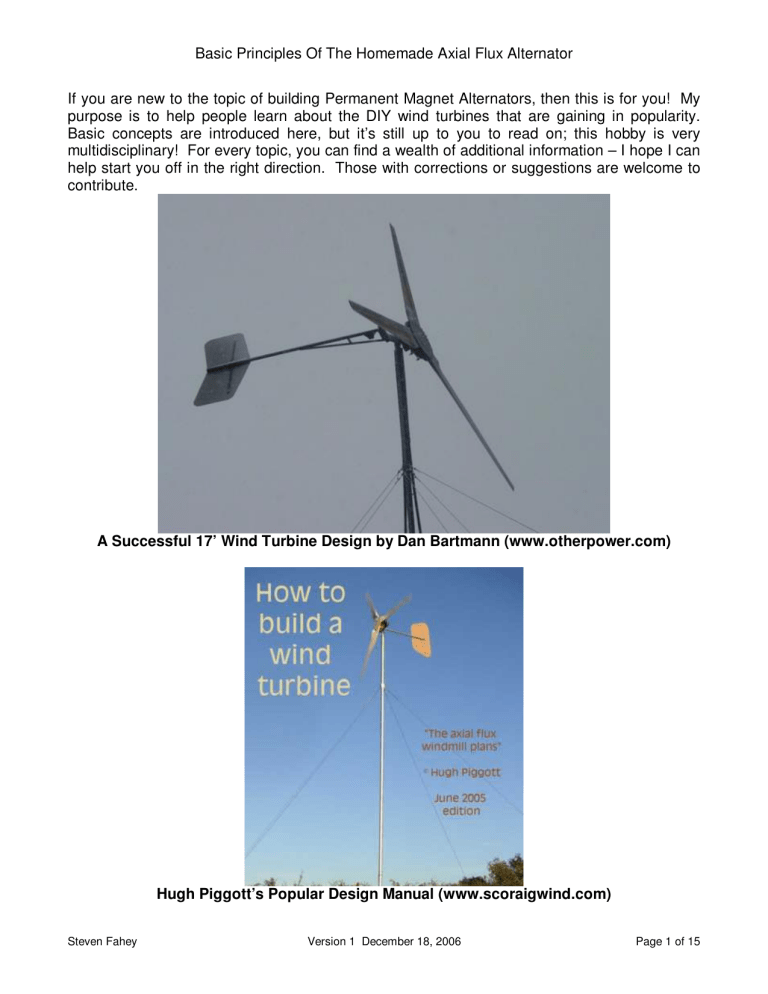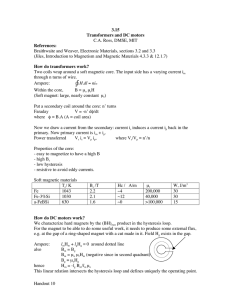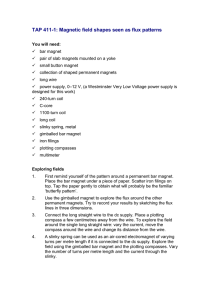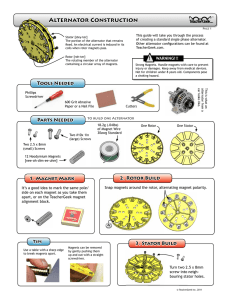Axial Flux Alternator

Basic Principles Of The Homemade Axial Flux Alternator
If you are new to the topic of building Permanent Magnet Alternators, then this is for you! My purpose is to help people learn about the DIY wind turbines that are gaining in popularity.
Basic concepts are introduced here, but it’s still up to you to read on; this hobby is very multidisciplinary! For every topic, you can find a wealth of additional information – I hope I can help start you off in the right direction. Those with corrections or suggestions are welcome to contribute.
A Successful 17’ Wind Turbine Design by Dan Bartmann (www.otherpower.com)
Steven Fahey
Hugh Piggott’s Popular Design Manual (www.scoraigwind.com)
Version 1 December 18, 2006 Page 1 of 15
Basic Principles Of The Homemade Axial Flux Alternator
Magnets
The Neodymium magnet has been a key technological development that allows practical and efficient alternators to be built. The high strength of Neodymium is part of what makes computer hard drives so compact. Now the material is avaialble commercially for all sorts of purposes. Many sizes now available are perfect for use in the DIY alternators. Below are pictures of some common sizes that are used:
2” x 1” x 0.5” 1” Diameter x 0.5” Circular Arc
“Magnetic field” is the technical term for the lines of force that are often drawn to symbolize the magnetic field around the magnet. The magnetic field intensity is measured in either Teslas
(after the inventor Nikola Tesla), or Gauss (after the mathematician). The symbol “B” is used for the field intensity (like “F” for force, “W” for weight). The intensity, B, gets stronger as you get closer to the magnet, since the lines get closer together.
There is always a North Pole and a South Pole. The magnets we prefer to use have poles on the faces with the most surface area. The example magnets shown above are more flat in one direction: the poles are on the broadest faces. Some types of magnets are longer on the polarized axis, but an axial flux alternator is efficient and lighter when the magnets are just big enough for the job, and no bigger.
Magnetic Field Lines Around a Magnet
When magnets are made, the magnetic poles are “frozen in” with an external electromagnet as the metal cools. If a magnet gets too hot, its strength will weaken.
Steven Fahey Version 1 December 18, 2006 Page 2 of 15
Basic Principles Of The Homemade Axial Flux Alternator
Magnetic Fields
A few illustrations will improve the understanding of how magnetic fields are manipulated.
When magnets are attracted to metallic objects, the attraction can be witnessed by a distortion of the field lines that we saw above. The lines are drawn to that object, in much the same way that the object itself is drawn to the magnet. As the magnet gets closer to the plate, field lines pass through the plate and get stronger. The increasing size of the arrows in the diagrams below illustrates this.
MAGNET
IRON PLATE
Flux Lines Through an
Object Attracted to a Magnet
Flux Lines Through an Object in Contact With a Magnet
When the plate is in contact with the magnet, the field lines can become very concentrated in the plate. They concentrate themselves in the plate, and if the plate is thick enough, very few lines emerge out the other side. Through the neodymium magnet itself, the magnetic strength doesn’t change much.
In a sense, holding a magnet beside the plate of iron is like holding a ball above the ground.
The ball falls due to gravity, and it comes to rest at a lower potential energy. Same with the piece of iron; once it is in contact with the magnet, the potential energy is lower.
The magnetic field of the magnets is manipulated in this way. The next illustrations show two magnets that are close together. If similar poles are close together, then the lines diverge, and the effect is felt as repulsion. If their opposite poles are close together, then the lines converge
(attraction). As they get closer, more lines get closer together, making the field more intense.
Magnetic Repulsion Magnetic Attraction Magnets in Proximity
(dense field lines)
Steven Fahey Version 1 December 18, 2006 Page 3 of 15
Basic Principles Of The Homemade Axial Flux Alternator
Concentrating Magnetic Energy
The magnetic field is manipulated to our advantage, when making permanent magnet alternators. By concentrating the magnetic flux between two opposite magnet poles, and capturing the flux in iron plates that would otherwise be wasted, we direct as much energy as we can through the gap between the faces.
The final product usually looks like this:
This set of rotors features round magnets.
This is common on smaller axial-flux alternators, but as they get larger, it is often more practical to use rectangular magnets, which are available in larger sizes, and the wire coils are more compact. It is important that the rotors be made of steel or iron, so that the magnetic flux is conducted by them.
The magnets are arranged in a N-S-N-S pattern around the circumference of the rotors. Opposite poles face each other. If you trace the lines of flux, they travel from one magnet face, straight to the magnet face opposite, then travel through the steel rotor plate to the next magnet, and back across the gap. Coils of wire in the gap capture the magnetic energy in those field lines.
Rotors of a Small Permanent-Magnet Alternator
ROTOR PLATE
MAGNETS
“THE GAP”
MAGNETS
ROTOR PLATE
Flux Lines Traced Through a Dual-Rotor Permanent-Magnet Alternator
The path of magnetic flux should be more clear with the diagram above. The flux has been concentrated by confining it between the plates. The flux also alternates between North and
South. A compass inside this gap as the rotors turn would flip back and forth frantically. A compass outside the plates is weakly affected, because the fields have been confined.
Steven Fahey Version 1 December 18, 2006 Page 4 of 15
Basic Principles Of The Homemade Axial Flux Alternator
Harnessing the Magnetic Energy
Now we come to the humble coil of wire. It doesn’t do much on its own, but in the presence of magnetic fields, interesting things happen. A single loop of wire encloses a certain amount of area. The field passing through this area is a “magnetic flux”. It is measured in Webers.
Not much happens when the surrounding magnetic field is sitting still, but when you put the system in motion, a voltage potential is produced. The more rapidly the magnetic field changes (either greater or lesser), the more voltage is created.
It doesn’t actually matter how the field is changed for the phenomenon to occur. You may have magnets that get closer together, that oscillate back and forth, flip over and over, or perhaps you don’t move the magnets at all, and instead flip the coil back and forth.
In our machine, coils of wire are held steady, while the magnets spin past on the rotors.
Because the magnets were arranged N-S-N-S, the direction of the field flips each time a magnet goes by. Each coil sees a flipped magnetic field, and pulse of electricity is produced.
When the field flips back, a pulse of opposite voltage is created. This coil is now producing alternating voltage.
Here is a set of 9 coils that were wound for a Permanent Magnet Alternator. They are all the same size, and have the same number of turns each.
Wire comes in a variety of sizes. The diameter (or “gauge”) of the wire determines the maximum amount of current it can carry. Heavier wire can carry more current than thinner wire. The builder selects a wire size that allows the current required for his design, but no bigger.
If a single loop of wire captures a certain amount of voltage in a changing magnetic field, then more of those loops will capture more voltage. The builder wants many turns of wire to capture as much as possible. This objective conflicts with the objective of allowing more current, because heavier wire takes more space. Less turns of heavy wire, or more turns of thin wire. A balance is sought by the builder to meet his needs. Experienced builders know off-hand how to strike the right balance. It is more of a mystery to the new recruit. Hopefully the diagrams at the end of this document will help.
Steven Fahey Version 1 December 18, 2006 Page 5 of 15
Basic Principles Of The Homemade Axial Flux Alternator
Coils of Wire in the Stator
If regular jacketed wire was used to wind coils, a lot of space would be wasted in plastic jackets. A solution was found a long time ago, and wire can be bought that is coated in a thin non-conductive enamel. When coils of enamelled wire are wound, each loop is isolated from the other, and the maximum compactness occurs.
Connecting the coils of wire introduces an important question in the design of the Permanent
Magnet Alternator: Will there be 3 separate phases or just 1?
Single phase alternators are simple to hook up – all coils are wired in series with each other, and they all work together to make one large pulse at the same time. While this is simple, the windmill experiences quite an abrupt “bump” for each pulse. It can hinder windmill performance and cause damaging vibration. Builders still use single phase when it’s convenient, and adapt the design to resist the vibration. It is also more complicated to overcome the inefficiency when rectifying that voltage to put DC into a battery, but it can be done.
A more elegant solution is to wire up the coils for 3-phase operation. At any given point, only one third of the alternator is at peak power, the other two are either dropping or rising to their next peak. Vibration is reduced not only by having peak currents 1/3 as intense, but also by having them 3 times more often. When rectifying the 3-phase power so that a DC battery can be charged, the current is also much smoother. The cost of extra rectifiers should not be considered an obstacle. They will last a long time if properly selected.
When the coils of wire are cast together into one plate, they are supported as a unit called a “stator”
(it remains “static” while the rotor rotates). Builders usually arrange the coils in a star-shaped pattern in a flat mould. Into the mould they pour a polyester or epoxy resin.
Then they close the mould, and when it has cured, the stator comes out as one big disk with the coils encapsulated inside. All of the internal electrical connections were made in advance. Either they selected one particular 3-phase connection arrangement, or they have enough wires coming out to allow some external connection changes. (See Appendix B for how it can be done).
Steven Fahey Version 1 December 18, 2006 Page 6 of 15
Basic Principles Of The Homemade Axial Flux Alternator
Magnet and Coil Matching
In an alternator producing 3-phase power, then one group of coils is at peak current while the others are not. Therefore the magnets align with only one phase at a time. Instead of figuring out how this is done from scratch, here’s the trick:
For every coil of wire in the 3-phase stator, there are 1.33 magnets.
Coils
6
9
12
15
18
Magnets
8
12
16
20
24
# Coils Per
Phase
2
3
4
5
6
No, don’t go slicing a magnet in half. The absolute minimum number of coils in a 3phase alternator is 3 coils. One for each phase. You would therefore need 4 magnets. Actually, that would be fairly clunky. Here are some typical combinations:
Anything with more than 24 magnets is getting complicated, and the first-time builder should beware. Similarly, varying the proportion of magnets and coils begs trouble, unless you know how to avoid the pitfalls of making single-phase alternators (but you wouldn’t be a newbie).
Matching the Alternator and Prop
The decision on how many coils/magnets to put into the Alternator is somewhat arbitrary, somewhat mystical. Basically, the more coils you have, the more voltage you produce (if all other parameters stay the same). The stator will produce less current, but that may be offset by a windmill speed range that captures more energy in the long run.
So far, we haven’t mentioned the wind mill blades that will ultimately be attached to the alternator. When at the point of deciding how to configure the stator, the size and design of the windmill must also be considered. Does the windmill run fast or slow? Are there often strong winds that, if harnessed, would be of benefit? Are winds usually light, requiring a windmill that gets the most out of a gentle breeze?
Once a size and speed range of the windmill has been chosen, the builder can proceed with the selection of a stator configuration. Usually, the purpose of this machine is to charge batteries. If you hook the PMA to the rectifiers, and the rectifiers to the batteries, then you effectively clamp the voltage to a specific value, either 12V, 24, or sometimes 48V, depending on your system. The size and gauge of wire should be selected to produce the right voltage.
The batteries are a load on the Alternator. The charging voltage will rise to a peak level (about
10% above the battery’s standard voltage), and then all your gains are in the current produced.
It takes more work for the alternator to produce more voltage. In the windmill situation, higher winds turn the mill faster, and provide more energy to overcome the heavy load. If the blades are too small, however, there won’t be enough energy to start the alternator in low wind. If the blades are too big, the alternator won’t load the prop efficiently and they will spin too fast.
Steven Fahey Version 1 December 18, 2006 Page 7 of 15
Basic Principles Of The Homemade Axial Flux Alternator
Mounting The Rotor and Stator Together
The stator is fixed while the rotor turns. How do people usually put this together? The best way to start is to see how others have done it. There are several ways, but most resemble the hub of an automobile; in fact, automobile hubs are usually used!
You can see 12 coils in these stators:
There are 16 magnets on the rotors below:
Below you can see the process of assembly of the rotors and stator.
One Magnet Rotor Mounted to Hub
Jacking Screws Extend Up to Mount
And Adjust The Opposite Rotor
Rotor and Hub Mounted on Tower Head
Stator is in Position in Front of The Rotor
Steven Fahey Version 1 December 18, 2006 Page 8 of 15
Basic Principles Of The Homemade Axial Flux Alternator
Second (Opposite) Rotor Being
Lowered Into Position
Technical Data
Second Rotor in Position
What performance should the Permanent Magnet Alternator have? Dan Bartmann tests his alternators and has collected a lot of data over the years.
The Rotors weigh 23 pounds each (13 Pounds of magnets + steel plate X 2)
The Stator weighs nearly 20 pounds (16 pounds of copper)
At 80 RPM, this alternator will produce 50 Volts, unloaded. When connected to a 48V Battery system, Dan has recorded 600 Watts at 100 RPM. (Roughly 12 Amps). This is actually a fairly large PMA, suitable for a windmill size of about 17 feet diameter. At higher wind speeds, the prop turns much faster and he can capture upwards of 3 kiloWatts.
A more modest size of alternator, with a 6-8 foot prop, could also produce up to 500 Watts, but at a significantly higher RPM. Smaller props naturally turn faster, so a good match can be made by the beginner who works carefully to select prop and alternator operating ranges that coincide.
Steven Fahey Version 1 December 18, 2006 Page 9 of 15
Basic Principles Of The Homemade Axial Flux Alternator
Where to Start With Your Wind Turbine
There are a lot of questions to be asked at the beginning. One of the best ways to start is to pick something that works, that is well documented, and to follow the instructions carefully.
Hugh Piggott, Dan Bartmann, and Ed Lenz all have well-designed wind turbine projects that offer the beginner an excellent start. And they’re not the only ones.
What will I do with the power? 1
Often Renewable Energy systems are designed to charge a bank of batteries. An inverter turns the battery voltage into AC that household appliances and lights can use. It doesn’t have to be this way. You may want to put the energy to heating coils in your house’s heating system. Maybe you want to heat water. The electricity may be useful in your house, or instead in a remote building with no power at all. Maybe you’re ambitious and can feed it back into the grid. (Or maybe you’re looking for the perfect lawn ornament to impress your neighbour).
2 How much power do I need?
That jumbo windmill could light every light in your house, but how can you commit to that scale of project on your first time out? You don’t seriously think you can run your air conditioning system all summer on a puny wind turbine, do you? If you’re building it just for the fun of it, then the right size is the size you can handle. If you have a purpose in mind, then figure out what you need, apart from what you want, and how you can conserve to make the job easier.
Where will the wind come from? 2
Something we often take for granted. “Just build it – then put it in the wind…” but most of us live near trees, buildings, neighbours, etc. The location and the wind you’ll get had better figure into the design early. If you have light wind most of the time, then you probably want a large windmill that’s producing power even when turning slowly – though it won’t be able to take full advantage of strong winds. Or… you often get strong winds and want to capture all that energy – but it may not produce anything in lighter breezes.
3 How long will this take?
This project could take a while. You’re going to draw a lot of drawings, cut a lot of wood, drill a lot of holes in steel, weld a lot of tubing, mix lots of epoxy, wind a lot of wire, and stand around scratching your head in puzzlement quite a lot, too. My dumb mistake: building two simultaneously. It takes twice as long to get anything finished!
Do I have to do it myself? 4
There are a lot of companies that build these things for you. You get the whole thing, too; tower, inverter, batteries, etc. Go the DIY route if you’re sure you’re going to enjoy the experience and finish the job. But you don’t seriously think that DIY is a lot cheaper, do you?
Steven Fahey Version 1 December 18, 2006 Page 10 of 15
Basic Principles Of The Homemade Axial Flux Alternator
To Learn More
Below is a brief bibliography of places to go to learn more about building windmills. You can start here, and then venture out into the enormous volume of information
DIY Projects
Hugh Piggott
Dan Bartmann
Ed Lenz
The Backshed
Scientific Research
Sandia National Labs
NREL
UIUC Airfoil Data
ECN (Dutch)
Electrical Theory www.scoraigwind.com
www.otherpower.com
www.windstuffnow.com
www.thebackshed.com/Windmill www.sandia.gov/wind/ www.nrel.gov/wind/ www.ecn.nl/en/ www.ae.uiuc.edu/m-selig/
All About Circuits
FEMM (Magnet Models)
Commercial Wind Turbine Manufacturers www.allaboutcircuits.com/ www.femm.foster-miller.net/index.html
Bergey Windpower
Southwest WindPower
Jacobs
Windmission
Marlec
Flowtrac
African Windpower
AeroMax
Wind Energy Associations and Watchdogs
AWEA (USA)
CANWEA (Canada)
Danish Wind Insustry Assoc.
AusWEA (Australia)
Wind-Works by Paul Gipe www.bergey.com/ www.windenergy.com/ www.windturbine.net/ www.windmission.dk/index.html
www.marlec.co.uk/products/products.htm
www.nimnet.asn.au/~kali/ www.scoraigwind.com/african36/ aeromag.com/ www.awea.org
www.canwea.ca
www.windpower.org
www.auswind.org/auswea/index.html
www.wind-works.org/
Steven Fahey Version 1 December 18, 2006 Page 11 of 15
Basic Principles Of The Homemade Axial Flux Alternator
Appendix A - Wire Gauge Table
23
24
25
26
27
18
19
20
21
22
14
15
16
17
9
10
11
12
13
7
8
5
6
3
4
1
2
AWG gauge
Diameter
Inches
OOOO 0.46
OOO 0.4096
OO 0.3648
0 0.3249
0.2893
0.2576
0.2294
0.2043
0.1819
0.162
0.1443
0.1285
0.0403
0.0359
0.032
0.0285
0.0254
0.0226
0.0201
0.0179
0.0159
0.0142
0.1144
0.1019
0.0907
0.0808
0.072
0.0641
0.0571
0.0508
0.0453
Diameter mm
Ohms per
1000 ft
11.684 0.049
Ohms per km
Maximum amps for chassis wiring
0.16072 380
10.40384 0.0618 0.202704 328
9.26592 0.0779 0.255512 283
8.25246 0.0983 0.322424 245
Maximum amps for power transmission
302
239
190
150
7.34822 0.1239 0.406392 211
6.54304 0.1563 0.512664 181
5.82676 0.197 0.64616 158
5.18922 0.2485 0.81508 135
4.62026 0.3133 1.027624 118
4.1148 0.3951 1.295928 101
3.66522 0.4982 1.634096 89
3.2639 0.6282 2.060496 73
119
94
75
60
47
37
30
24
2.90576 0.7921 2.598088 64
2.58826 0.9989 3.276392 55
2.30378 1.26 4.1328 47
2.05232 1.588
1.8288 2.003
5.20864 41
6.56984 35
1.62814 2.525
1.45034 3.184
1.29032 4.016
1.15062 5.064
8.282 32
10.44352 28
13.17248 22
16.60992 19
1.02362 6.385
0.91186 8.051
0.8128 10.15
0.7239 12.8
0.64516 16.14
0.57404 20.36
0.51054 25.67
0.45466 32.37
0.40386 40.81
0.36068 51.47
20.9428
26.40728 14
33.292
41.984
52.9392
16
11
9
7
66.7808 4.7
84.1976 3.5
106.1736 2.7
133.8568 2.2
168.8216 1.7
2.3
1.8
1.5
1.2
0.92
0.729
0.577
0.457
0.361
0.288
5.9
4.7
3.7
2.9
19
15
12
9.3
7.4
Steven Fahey Version 1 December 18, 2006 Page 12 of 15
Basic Principles Of The Homemade Axial Flux Alternator
28
29
30
31
32
Metric
2.0
33
Metric
1.8
34
Metric
1.6
35
0.0126
0.0113
0.01
0.0089
0.008
0.00787
0.0071
0.00709
0.0063
0.0063
0.0056
Metric
1.4
36
Metric
1.25
.00551
0.005
.00492
37
Metric
1.12
38
0.0045
.00441
40
0.004
Metric 1 .00394
39 0.0035
0.0031
0.32004
0.28702
0.254
0.22606
0.2032
0.200
0.18034
0.180
0.16002
0.16002
0.14224
.140
0.127
0.125
0.1143
0.112
0.1016
0.1000 670.2
0.0889 831.8
0.07874
64.9
81.83
103.2
130.1
164.1
169.39
206.9
207.5
260.9
260.9
329
339
414.8
428.2
523.1
533.8
659.6
1049
212.872
268.4024 1.2
338.496
426.728
538.248
555.61
678.632
680.55
855.752
855.752
1079.12
1114
1360
1404
1715
1750
2163
2198
2728
3440
1.4
0.86
0.7
0.53
0.51
0.43
0.43
0.33
0.33
0.27
0.26
0.21
0.20
0.17
0.163
0.13
0.126
0.11
0.09
0.056
0.056
0.044
0.043
0.035
0.034
0.0289
0.0277
0.0228
0.0225
0.0175
0.0137
0.226
0.182
0.142
0.113
0.091
0.088
0.072
0.072
Steven Fahey Version 1 December 18, 2006 Page 13 of 15
Basic Principles Of The Homemade Axial Flux Alternator
Appendix B - Neo Magnet Data
Steven Fahey Version 1 December 18, 2006 Page 14 of 15
Basic Principles Of The Homemade Axial Flux Alternator
Appendix C - 3-Phase Connections
The simplest way to connect the coils of a 3-phase alternator is in “Star”. Join the ending wires together, and the three start wires come out. Each phase comes out of the start wires.
Alternatively, a “Delta” connection can be made by joining the starts and ends of each successive phase together.
Steven Fahey Version 1 December 18, 2006 Page 15 of 15



